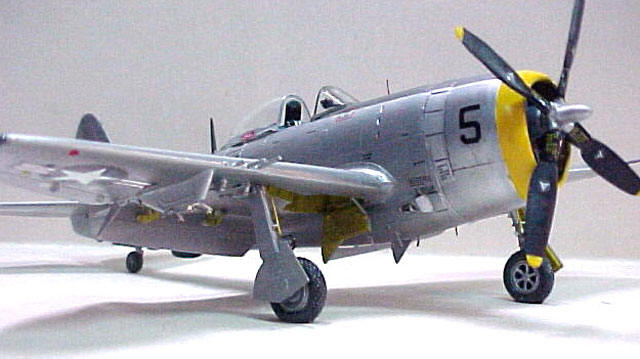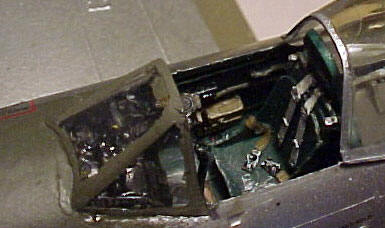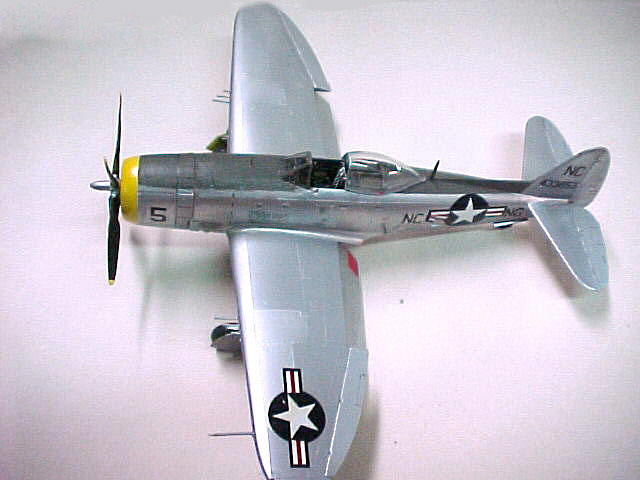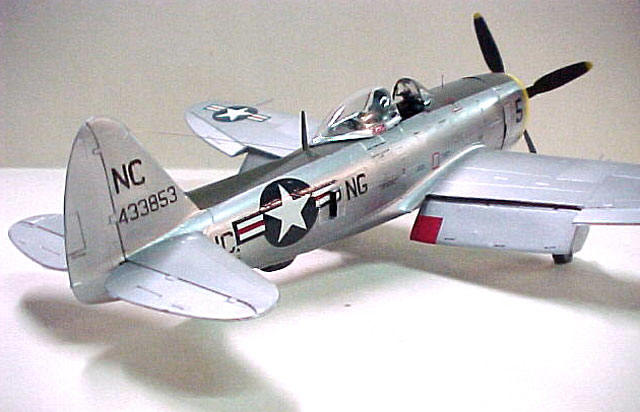|
North Carolina Air National
Guard
The Prop Fighters Part One:
A Tarheel T-Bolt
Feb. 1948-Dec. 1949
by Joe Lyons


HyperScale is proudly supported by Squadron
The Guard and the Air Guard are much in the news of late.
The US National Guard is a unique military formation under the control of the
various states, except when “federalized.” The Air Guard dates back to the
formation of the US Air Force in the immediate post-war era. On May 24 1946 the
360th Fighter Squadron, a 1st AF unit formed in December
1942, was redesignated the 156th Fighter Squadron and allocated to
the North Carolina National Guard. In March 1948, the year after the creation of
the United States Air Force, the 156th was extended federal
recognition and the North Carolina Air National Guard was born. The mission
aircraft was the P-47 Thunderbolt. NC ANG Jugs star in “Fighter Command,” an
otherwise mediocre movie that has a lot of great T-bolt footage.
The 156th was based at Morris Field (soon to
become Douglas Airport) in Charlotte, NC. Part of my misspent youth was misspent
in Charlotte, and the nearby airport provided many aviation experiences and
memories.
The
Airplane
The P-47 was common ANG equipment in those days when there
were thousands of almost new airplanes to stock the new units. The post-war
active air force mostly kept P-51s for its prop fighter at the dawn of the jet
age. There were a few P-47 units left in Europe for a while, but the big ‘Bolt
had disappeared by the start of the Korean War.
I have visited NC ANG headquarters in Charlotte and had a
look at a year book-like collection of old photos, one of them providing the
inspiration for this project. The subject is a P-47D-30-RA, serial number
433853, one of 1800 –30s built at Evansville. It’s probably a good bet that
433853 never went overseas.
There are a rich variety of modeling references for the
P-47s and, as one would expect, they sometimes offer differing opinions on
things. Roger Freeman’s Ducimus book (reference e), “Republic Thunderbolt”
provides the best synopsis of the evolution of the P-47 variants and it says of
the P-47D-30-RA:
Engine R-2800-59
Propeller Curtiss Electric C-642S-B 13’0”
diameter
“Other data similar to P-47D-26-RE”
“Changes similar to P-47D-30-RE”
From the –26 the only significant thing to note is that
it’s a bubbletop
From the –30-RE, zero-length rocket rails are added, and
there is a different model number Curtiss 13’0” prop.
Zero Length Rocket rails
Sources differ on when these got to production “D”
models. Freeman says in Block 30, reference b says Block 40, with Block 30s
getting retrofit kits per reference g. Not sure who to believe: I have found
ONE photo of a post-war –30 with rails, and then only two per wing. Plus,
only a couple of post-war shots with –40s with rails, and many without. Many
photos of wartime and post-war –30s without rails.
Dorsal Fin
Everyone agrees these show up in production with the
D-40, -30s being retrofitted. Photos confirm; haven’t found one –30 without
it.
Ring and Bead Sight
One source (reference b) that talks about this says, it
disappeared with the –30. However reference h has a photo of a preserved
as-is not restored –30 showing it installed.
Brett Green’s marvelous book on the P-47 (reference g) only
looks in detail at what he calls the “modern” 1:48 releases, although the
groundbreaking Monogram kits get honorable mention. This model is of course the
kit that is older than my children, first built by me in bubbletop form in 1973.
It is said to be somewhat inaccurate in the placement of the wing, a problem
apparently fixed in the razorback release. I built it anyway, then and now. The
kit is Monogram #5487 with the P/E set.
The kit is OOB with the following additions:
- TD 48483 resin cockpit set intended for the Academy
kit
- Eduard P/E set #48240 intended for the Academy kit.
(Selected pieces)
- Medallion dorsal fin
- Medallion Curtiss 13’ Prop (I believe this to be the
asymmetrical version, fourth and last in the P-47 prop saga)
- Medallion resin flaps. This aftermarket set also came
with control surfaces that were not used.
- Scratch-built underwing compressibility flaps
- Zero-length rocket rails from a Hasegawa P-51 or F4U
(forget which), 2 per wing inboard of the stores pylon.
- CMK aftermarket wingtip lights.
- Cutting Edge Mk 8 gun sight replacing the kit sight,
plus Eduard ring and bead sight.
- Wire antenna, fin to fuselage, for the Detrola DF
receiver.
- Copper wire used for brake lines.
- True Detail six-spoke wheels
- 25 thou steel wire to represent the fuselage stores
sway braces.
- Flap hinges reproduced with card stock.
1. Engine: Used the Medallion white metal Curtiss
prop in lieu of the kit Hamilton Standard Prop. Accessorized the engine with
Eduard P/E.
2. Cockpit: Interior fuselage rib detail in the way
of the cockpit removed. Added the TD cockpit, using the kit P/E rudder pedals
and support. Filled in the floor corrugations. Added scratch hydraulic pump
handle. Added Eduard P/E tail wheel lock, and port and starboard cockpit lights.
Added card stock rear bulkhead behind seat.

Replaced kit representation of Mk 8 gun sight reflector
with Cutting Edge substitute. Installed the Eduard ring sight attached to the
reflector sight, and the accompanying external bead fore sight.
“Getting Anal About Radio Controls….” This is for
those whose AMS needs are no longer being met merely by fixating on wheel wells.
Brett notes there are five cockpit sets out there for the P-47, mostly for the
“D,” and he displays photos of some of them, plus photos of OOB cockpits as
well.
Click the
thumbnails below to view larger images:
“And your point is…?” you ask. I say that the radio
controls on the starboard side of cockpit of these sets (less the one for the
P-47N) are not accurate for any but the P-47C, because they are of the SRC-274-N
radio(s), which were replaced by the VHF SRC-522-A (a.k.a. RAF TR 1143). The
cockpit controllers were quite different, being three identical side-by-side
units for the SRC-274 and one for the SRC-522. The True Details set #48483 is
alleged to be for the block -30/40 aircraft, per Brett, but the set itself
advertises as for the P-47D-25. It has the earlier controls and a corrugated
floor. Mine may be an earlier release with the same number.
3. Exhausts: Thinned out the waste gates up front,
and the intercooler exhaust flaps back aft.
4. Fin: Cut out a wedge at the base of the fin for
the Medallion dorsal fin, which was glued in place and faired in with putty.
Exterior: The overall NMF is Alcad II over a
base coat of Plasti-Cote No. 305 silver base coat auto lacquer. The anti-glare
area is Testor’s MM Olive Drab. The supercharging housing is done with MM
Exhaust metalizer, and the surrounding panel in Polly Scale flat aluminum. Wing
leading edges, the gun and ammunition bay panels and the control surfaces are MM
Non-Buffing Aluminum metalizer. Pactra Yellow is used for the cowl ring.
Control surface hinge lines, cowl flaps, cowl panels and various vents were
picked out with a Pigma Micron 01 black marking pen.

Cockpit: Reference h has some cockpit
photos of an unrestored –30. This is good: all the talk of what is or is not
Dull Dark Green and all the other “inside” greens of the era makes my head hurt.
I think the closest approximation available out of a bottle or tin to what these
photos show me is Humbrol Deck Green, an RN ship color.
Other non-crew interior areas: The color
photos of Republic-built period P-47s in reference h show yellow Zinc Chromate
for the inside of the gear doors, so Testor’s 1184 is used for these areas, the
flap hinges, the inside of the cowl and the wheel wells. This is at variance
with color photos of restored P-47s and, Brett has chosen Interior Green for his
models. I respectfully disagree; see particularly the front covers of references
d and h.
Markings: Aircraft specific markings such as
the radio call number, “NC NG,” and cowl number were done in Power Point and
printed on an HP ink-jet printer. Post-1947 national insignia came from a
Pro-Modeler decal sheet for the P-47N. A SuperScale P-47 Razorback decal sheet,
#48-663, supplied stencils.
A Thunderbolt Comment
I have no proof, but would opine that the Tarheel T-bolts
were flown by at least by a few USAAF 8th AF veterans. I have a
special admiration for those embattled P-47 pilots who, deep within hostile
airspace in the fall of 1943 a long time before the fabled Mustangs appeared and
always outnumbered at the point of contact, wrested control of the air from the
Luftwaffe as they fought to defend B-17s a long way from home.
After completing his first attack he turned
and led his own flight back around the side of the bomber force to prepare
for a second frontal attack. And that is when the sky fell in on Major
Galland and his unit, for American fighters were suddenly all around them…Zemke
knew that the B-17s were returning from a particularly dangerous mission and
would need all the help his unit could give. He was always trying to squeeze
a little more range out of the leaky, faulty drop tanks his P-47s had to
rely on at that time and he somehow managed to find that fifteen extra miles
of range which had just surprised the Germans. The American pilots arrived
with every possible advantage. Their initial approach was from out of the
sun, 5000 feet above the Germans and they actually flew over the scene of
action before turning and deploying themselves in the manner in which Zemke
had ordered – one squadron on either side of the last combat wing and one
squadron to cover the next combat wing ahead…. The unsuspecting Germans did
not see the American fighters sweep overhead and were thus doubly surprised
when the P-47s turned and swooped down on them from out of the east…Major
Galland’s body, in the remains of his fighter, was not found until nearly
two months later…. Colonel Zemke led the 56th Fighter Group… deep
into German-defended airspace and caught …an experienced German leader by
surprise and at a tactical
disadvantage.
(Middlebrook)

Thoughtful Luftwaffe commanders may have known it was not
going to get any better:
Despite these measures, attrition continued to take its toll. Especially
damaging was the impact on the Luftwaffe’s aces in the fall of 1943. The aces
listed in Table 2 were in the van of a swelling number of the Luftwaffe’s best
that fell in the battle for air superiority during the closing months of 1943.
Together these twelve pilots had claimed 1160 Allied aircraft…. Many German
fighter pilots learned a fatal lesson over the next six months: combat
experience and tactics learned on the Eastern Front were of only limited use
against superbly trained and equipped American pilots on the Western Front.
(Mcfarland and Newton)
In the fall of 1943 most of the Luftwaffe attrition in
the great daylight air battles over Germany can be credited to often-maligned
the P-47. At the time, no other allied fighter was capable of doing this: not
one.
All photos are
either that of the author, or in the public domain.
a.
Army Air Forces (1943). Pilot’s Flight Operation Instructions P-47B,
-C, -D and –G Airplanes [Technical Order No. 01-065BC-1). Fairfield, OH: Air
Service Command. [Reprinted by Aviation Publications]
b.
Davis, L (1984). P-47 Thunderbolt in Action. Carrollton, TX:
Squadron/Signal Publications.
c.
Drendel, L. (1997). P-47 Thunderbolt Walk Around. Carrollton, TX:
Squadron/Signal Publications.
d.
Ethell, J. (1983). American Warplanes World War Two-Korea Volume I.
London: Arms and Armour Press.
e.
Freeman, R. (1990). The Mighty Eighth War Diary. Oceloa, WI:
Motorbooks International.
f.
Freeman, R. Republic Thunderbolt. London: Ducimus Books.
g.
Green, B (2004). Modelling the P-47 Thunderbolt. Oxford, UK:
Osprey Publishing.
h.
Kinzey, B (1998). P-47 Thunderbolt in Detail & Scale. Carrollton,
TX: Squadron/Signal Publications.
i.
McFarland, S and Newton, W. (1991). To Command the Sky the Battle for
Air Superiority over Germany, 1942-1944. Washington: The Smithsonian
Institution.
j.
Middlebrook, M (1985). The Schweinfurt-Regensburg Mission American
Raids on 17 August 1943. New York: Penguin Books.
Modelling the P-47
Thunderbolt
Osprey Modelling 11 |
|
|
|
|
Author: Brett Green
US Price: $17.95
UK Price: £12.99
Publisher:
Osprey Publishing
Publish Date:
July 25, 2004
Details: 80 pages; ISBN: 1841767956 |
|
|
Text Copyright © 2005 by
Joe Lyons
Images by USN or Joe Lyons
Page Created 17 September, 2005
Last Updated
17 September, 2005
Back to Reference Library
|
Home
| What's New |
Features |
Gallery |
Reviews |
Reference |
Forum |
Search